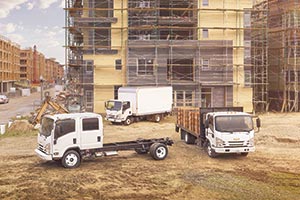Borne Back Ceaselessly Into the Past, Truck OEMs Return to Medium Duty

This story appears in the Nov. 28 print edition of Transport Topics.
The reintroduction of medium-duty models from three manufacturers will reconfigure that segment of the commercial truck industry, especially in the lighter weight classes.
Buyers will have more choices and may benefit from competitive pricing when the new models from Navistar, General Motors and Isuzu hit the market, but the additions will crowd an already busy sector, and gains will necessarily come at the expense of other manufacturers.
The growth of e-commerce is expected to continue, and that will drive the need for more light- and medium-duty trucks to handle deliveries to homes and businesses, Carl Webb, vice president and general manager of Navistar’s medium-duty line, told Transport Topics.
“[Medium-duty trucks] will play a big role in that ‘last mile’ delivery need,” Webb said. “There’s a huge need for medium-duty there.”
That is one of the applications General Motors and Navistar are targeting in a joint venture with new Classes 4-5 conventional cab trucks that the companies will develop and market under their respective Chevrolet and International brands. The trucks represent re-entry into the light- medium commercial truck sector for both companies.
GM discontinued its medium-duty Chevrolet Kodiak and GMC TopKick truck brands in 2009 after the 2008 economic downturn and the company’s subsequent bankruptcy. While GM continued to have a commercial vehicle structure in the intervening years, most of that group’s focus was no higher than cutaway vans.
The company began inching back into the commercial sector in 2015 with the introduction of the Chevrolet City Express, a small, commercial cargo van. That was followed by delivery this year of low-cab-forward Chevrolet models, said John Schwegman, director of commercial products at GM.
“It was time to expand our commercial portfolio,” he told TT, speaking about the low-cab-forward models and the new joint venture truck with Navistar.
“Customers want a single-source supplier, [and] our dealers were asking for more commercial products.”
Navistar’s hiatus from this sector will have been much briefer, having stopped production of its light-medium International brand TerraStar model just last year. The new truck, which will be called the CV (for Commercial Vehicle), essentially replaces the TerraStar.
The CV will be the last product rolled out as the company refreshes its entire lineup of trucks, begun last year with the vocational HX and continued this year with the linehaul LT model. The rollouts will continue until all of the Star-named models are replaced.
The DuraStar will become the MV Series, to be launched in 2017. The HV will replace the WorkStar and the RH (regional haul) will replace the TransStar, Webb said.
“The driver is the center of these improvements,” he said. “The CV will have more of a commercial feel to it, and the cabs will be more ergonomic, with better controls.”
These model refreshments are core to Navistar’s recovery from its decision earlier in the decade to opt for, and then abandon, advanced exhaust gas recirculation emissions control technology.
Few details about the truck, other than that it will have a GM-supplied diesel engine and automatic transmission, have been released. The trucks will be built at Navistar’s Springfield, Ohio, plant for delivery in 2018.
Navistar also will build GM’s cutaway G van at its Springfield plant beginning in 2017.
The low-cab-forward truck style, popular among urban delivery and landscaping businesses, was hit especially hard by the recession when the housing market collapsed. These models’ short cabs accommodate longer bodies, and their high visibility and tight turning radii make them ideal for maneuvering narrow streets.
GM and Isuzu Commercial Truck of America have had a decadeslong, on-and-off again relationship in this sector. Until 2009, Isuzu supplied Chevrolet and GMC with Classes 3-5 low-cab-forwards, and GM assembled Isuzu’s Class 6 F-Series model.
After GM pulled out of the market, Isuzu and Mitsubishi Fuso, a division of Daimler AG, had the light-medium low-cab-forward sector to themselves, but it also forced Isuzu to cancel its F-Series.
With GM and Isuzu’s cooperative arrangements back in place, both companies are returning to market.
Chevrolet is offering six low-cab-forward models — the 3500, 3500HD, 4500, 4500HD, 5500 and 5500 HD. The trucks are based on the Isuzu N-Series and are available with gasoline or diesel power. Prices start at $40,900 for the gas version and $48,375 for the diesel. Chevrolet will distribute the truck through about 250 dealers, Schwegman said.
Isuzu will begin offering a new FTR model in 2017.
Shaun Skinner, executive vice president and general manager of Isuzu, cited demographic shifts as support for the reintroduction of the FTR.
“As the adult population grows and as people move to urban centers, there will be an increasing need for delivery trucks that can carry a lot of cargo,” he said in a March 2016 release announcing the model.
The FTR will use the Isuzu 5.2-liter diesel and Allison 6-speed automatic transmission. Price details were not available.
The gasoline-powered versions for Chevrolet’s new models and Isuzu’s N-Series are assembled in Charlotte, Michigan, by Spartan Motors, which also builds Isuzu’s Reach van. Spartan also will assemble the F-Series truck at a new, dedicated facility.
Despite the increased competition in the medium-duty market, this sector already may be showing signs that sales have peaked, at least for the time being. Medium-duty sales are expected to remain flat for the next few years after spending the past seven years or so gradually recovering from the recession.
Through 10 months, 2016 U.S. retail sales of Classes 4-7 trucks were up 6% compared with the same period last year, but October sales dropped 14.9% from a year ago, according to WardsAuto.com.
The medium-duty market is much more diverse than the heavy-duty sector, and weak performance in some areas often is offset by strength in others.

